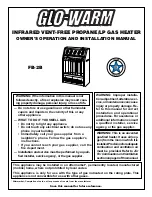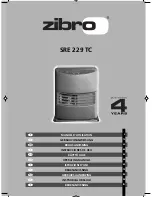
Commercial Electric Water Heater Use and Care Guide • 19
Step 10:
Adjusting the
Temperature
With the installation steps completed,
you may adjust the water heater’s
temperature setting if desired.
1
Set the thermostat(s) to
desired temperature.
The
thermostat(s) on this water
heater have been factory set to
approximately 140°F (60°C) to reduce
the risk of scalding. You may wish to set
a higher temperature to provide hot
water for automatic dishwashers or
laundry machines, to provide more hot
water capacity, and to reduce bacterial
growth. Higher tank temperatures
(140°F, 60°C) kill bacteria that cause a
condition known as “smelly water”
and can reduce the levels of bacteria
that cause water-borne diseases.
WARNING! Higher temperatures
increase the risk of scalding, but even at
140°
F (60°C), hot water can scald
(see page 4).
If you increase the water heater’s
temperature setting, install
Thermostatic Mixing Valve(s) to reduce
the risk of scalding.
Figure 20 -
Adjust Thermostatic Mixing Valves
to 120°F (49°C) or lower.
To adjust the water heater’s
thermostat:
• Be sure the electrical power to the
water heater is turned OFF at the
circuit breaker panel (or remove the
circuit’s fuses).
WARNING! Working near an
energized circuit can result in severe
injury or death from electrical shock.
Check wires with a circuit tester to
make sure power is off.
• Open the electrical junction box and
remove the lower thermostat access
panel. Do not remove the plastic
personnel protectors covering the
thermostats.
• Using a flat tip screwdriver, rotate
the adjusting knob to the desired
temperature setting (NOTE: It is
not necessary to adjust the upper
thermostat for a dual element unit.
However, if it is adjusted above the
factory set point 140°F (60°C) it is
recommended that it not be set
higher than the lower thermostat
setting).
• Fold the insulation back in place and
replace the access panels.
WARNING! Be sure panels are
secured to reduce the risk of fire and
electric shock.
2
Turn the electric power back
on.
3
Wait for the water to heat up.
It may take several hours for a
tank of cold water to heat up.
If you have no hot water after two
hours, refer to the Troubleshooting
Section (see page 21).
WARNING! If you have increased
the temperature setting and the
Thermostatic Mixing Valves are not set
properly (or not installed) you could
scald yourself while checking the
temperature.
4
Check water temperature at
several points of use in the
plumbing system (for
example, bathtub faucet, shower, or
lavatory sink) and adjust the
Thermostatic Mixing Valves as needed.
If you aren’t sure how to adjust the
Thermostatic Mixing Valve settings, or
aren’t sure if you have Thermostatic
Mixing Valves, contact a qualified
person.
INS
TALLA
TION














































